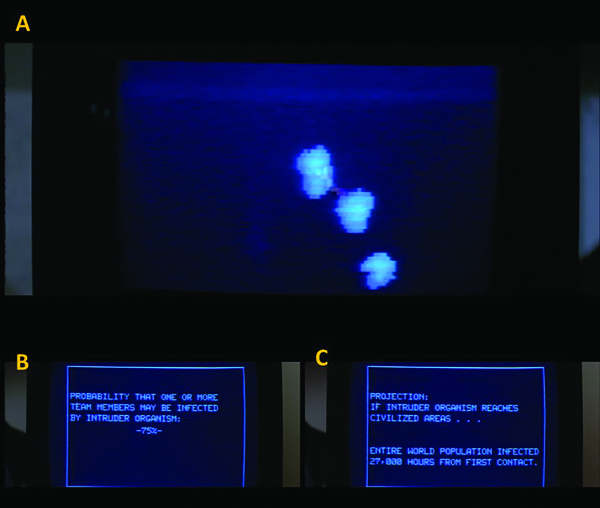ISSN electrónico: 1885-5210
DOI: https://doi.org/10.14201/rmc.31185
THE THING (1982): A FIRST PREDIAGNOSTIC MODEL FOR INFECTIONS AND ALTERATIONS OF PHYSIOLOGY
The Thing (1982): un primer modelo de prediagnóstico para las infecciones y alteraciones de la fisiología
Isabel PRIETO-GÓMEZ1; Manuel RAMÍREZ-SÁNCHEZ1; Ana Belén SEGARRA-ROBLES1; Nora SULEIMAN-MARTOS2; Francisco GARCÍA-CÓZAR3; Germán DOMÍNGUEZ-VÍAS4
1 Physiology Area, Faculty of Experimental Sciences. University of Jaén (Spain).
2 Department of Nursing, Faculty of Health Sciences of Granada. University of Granada (Spain).
3 Immunology Area, Faculty of Medicine. University of Cádiz (Spain).
4 Department of Physiology, Faculty of Health Sciences of Ceuta. University of Granada (Spain).
Corresponding author: Germán Domínguez Vías
Email: germandv@ugr.es
Recibido: 31 enero 2023
Aceptado: 6 febrero 2023
Abstract
The Thing (1982) represents an audiovisual challenge to think about the discovery of keys for the early detection of hostile infections. The search for quick and easy techniques for solving cases means the difference between survival and remaining suspicious for a group that tries to discover which of them are infected, and not end up transformed into «something else». This work will allow the student body to know the changes in the homeostatic balance that the relationship with microorganisms of different nature present in the blood would imply.
Keywords: physiology; homeostasis; microbiome; zoonosis; infection; mimic.
Resumen
The Thing / La cosa (El enigma de otro mundo) (1982) de John Carpenter, supone un reto audiovisual para pensar en el descubrimiento de claves para la detección temprana de infecciones hostiles. La búsqueda de técnicas rápidas y sencillas para la resolución de casos supone la diferencia entre la supervivencia y mantenerse en la desconfianza para un grupo que trata de descubrir quienes de ellos están infectados, y no terminar transformados en «otra cosa». Este trabajo permitirá al estudiantado conocer los cambios en el equilibrio homeostático que supondría la relación con los microorganismos de distinta naturaleza presentes en la sangre.
Palabras clave: fisiología; homeostasis; microbioma; zoonosis; infección; imitador.
Technical details
Original title: The Thing.
Country: United States.
Year: 1982.
Director: John Carpenter.
Music: Ennio Morricone.
Photography: Dean Cundey.
Film editor: Todd C. Ramsay.
Screenwriter: Bill Lancaster. Novela: John W. Campbell.
Cast: Kurt Russell, Wilford Brimley, Keith David, David Clennon, Richard Dysart, Donald Moffat, Richard Masur, T.K. Carter, Charles Hallahan, Peter Maloney, Joel Polis, Thomas G. Waites.
Color: Color.
Duration: 109 min.
Genre: Horror, fantasy, mystery, science fiction. Cult film.
Original language: english, norwegian.
Production Company: Universal Pictures, Turman-Foster Company, Province of BC, Ministry of Tourism, Film Promotion Office.
Synopsis: At an American research station in Antarctica, in the early winter of 1982, they observe the appearance of a helicopter from the nearby Norwegian research station flying over the American base trying to kill a sled dog. After the destruction of the Norwegian helicopter, members of the American team fly to the Norwegian base, only to discover all of its occupants dead or missing. They find the remains of a strange creature that the Norwegians burned. The Americans take it to their base and deduce that it is an alien life form. When they take the dog in, it viciously attacks both the humans and canines in the camp, and they discover that the beast, of unknown origin, can assume the form of its victims. After a while, it becomes apparent that the alien can take over and assimilate with other life forms, including humans, and can spread like a virus. This means that anyone on the base could be inhabited by «The Thing», and tensions rise.
Awards Nominee:
1982, Saturn Awards: Best Horror Film, Best Special Effects (Rob Bottin);
1983, Razzie Awards: Worst Musical Score (Ennio Morricone).
Availability: The Thing (Blu-Ray). Universal Pictures Home Entertainment.
Links:
https://pro.imdb.com/title/tt0084787/?rf=cons_tt_atf&ref_=cons_tt_atf
https://www.imdb.com/title/tt0084787/?ref_=ttfc_ql
Original trailer versions:
https://www.imdb.com/video/vi2298151193/?playlistId=tt0084787&ref_=tt_ov_vi

American poster version
Introduction
The Thing (1982) by John Carpenter is one of the best masterpieces of horror and science fiction (Position in rankings: IMDb Top 153/250; Filmaffinity Spain 37/1000) that deals with microbiological contamination and modifications of human cell biology. In the film, the tension is palpable when discovering that the cells of a being from outer space have the capacity to assimilate terrestrial cells and living organisms, digesting them and imitating their shape, abilities and knowledge (Photo 1). This fact sets a pace of frantic suspense due to the mistrust of living with someone who may be the imitation of a partner.

Photo 1. Cellular study of the unidentified exogenous microorganism (The Thing). They discover that it has the ability to assimilate (A - E) the cells of sled dogs and any living being, and imitate (F) the assimilated cell, as well as any other form of life
In the face of cell or tissue injury, cells undergo adaptation mechanisms until the end of the cessation of the stimulus, or succumb by apoptosis or necrosis due to the impossibility of adapting. Examples of adaptations to injury or the stressful environment are changes in cell size (atrophy/hypertrophy), number (hyperplasia, metaplasia - dysplasia) and/or shape. Blood is a medium that is considered sterile until the arrival of a systemic infection, however, under physiological conditions it is also easily detectable cells or exogenous DNA without manifesting signs and symptoms of a pathology. In this study we propose the physiological changes that can occur in the face of sepsis or, from another point of view, in the face of an alteration in the balance of the microbiome in the blood or dysbiosis, referring to a change in the composition of symbiotic or commensal microbial communities.
This film presents an interesting way to detect microbial agents through a blood sample collection on a Petri dish, to later apply a heat stimulus with a heated wire to the fire of a flamethrower (Photo 2). The reaction to a stressor or injurious agent would cause the detection and immediate withdrawal of the infectious agent.

Photo 2. Improvised protocol for blood sample collection and heat stimulation (A - B). Blood samples from healthy subjects give off vapor (C – E), however, the contaminated sample is revealed by the harmful stimulus (F)
Results and Discussion
Since the bloodstream has traditionally been considered to be a basically sterile environment, containing only blood cells, platelets, and plasma, the detection of microbes in human blood has been consistently interpreted as indicative of infection. However, while a controversial concept, evidence for the existence of a healthy human blood microbiome is constantly accumulating1. The controversy over the incidence of foreign cells in human blood dates back to 19692, when the presence of metabolically active bacteria was described in the blood of healthy human subjects. Specifically, the increased uptake of nucleosides and amino acids into erythrocyte suspensions led them to hypothesize the presence of bacterial microorganisms in the blood of individuals without signs and symptoms of disease2. Other studies dismantle these results by stating that the pleomorphic bacteria identified in the blood of healthy humans were nothing more than microparticles derived from disintegrated erythrocytes, specifically membrane vesicles and refractive blood proteins captured by dark-field microscopy3, 4. The blood-borne microbial phylogeny, as well as the origins, identities, and functional role of these highly unexpected microorganisms, remain a mystery. Even so, many recent studies are becoming known that suggest that the presence of bacteria in the blood is a consequence of translocation from other parts of the body: skin and mouth, maternal umbilical cord, but particularly the gastrointestinal tract without compromising the intestinal epithelial membrane5-7. Despite continuing evidence of bacterial taxa that make up the healthy blood microbiome in humans, the presence of other microorganisms, such as viruses, archaea, and fungi in the blood of healthy humans, are unknown1.
The presence of foreign microorganisms in human blood does not necessarily equate to an infection or disease state. In a state of dysbiosis, although the blood-borne bacterial microbiome is harmless, the high numbers can lead to a state of complex disorders and physiological disturbances. In real situations, the routine analysis of laboratory controls determines the taxonomic and metabolic characteristics of polluting taxa derived from the environment. It must be considered that many microorganisms found naturally in human blood may be in a latent state1. For this reason, culture-based methods are not reliable in supporting the existence of a human blood microbiome. In addition, although the number of microorganisms and their DNA concentration in the blood is usually very low, sensitive analytical techniques such as quantitative real-time PCR (qPCR) and Next Generation Sequencing (NGS) techniques target to specific disease loci, may corroborate current evidence for the presence of harmless bacterial taxa in the blood of healthy humans5. Other techniques used are transmission electron microscopy (TEM), dark field microscopy (DFM) and fluorescence in situ hybridization (FISH). In the case of the film, «The Thing» is a zoonotic agent with a contaminating action on human fluids and tissues that facilitates their digestion, assimilation and mimicry. In order for contaminated blood to react to heat damage, the dysbiosis in humans must be very significant, a fact confirmed in the film by representing each individual as a replica that imitates and replaces the original. In relation to mimicry, there is literature that shows that certain microorganisms adapt and imitate immune cells to regulate physiological processes or that they can imitate modulators of inflammatory processes and other autoimmune diseases8-10. For example, immune homeostasis in the gut is tightly controlled by FOXP3+ regulatory T cells (Tregs), whose defects are linked to the development of chronic diseases, such as inflammatory bowel disease. As an immune evasion mechanism, the intestinal parasite Heligmosomoides polygyrus enhances Treg activity by secreting a molecule (Hp-TGM) that mimics the ability of TGF-β to induce FOXP3 expression in CD4+ T cells8. The physiology of «The Thing» is adapted to the actual characteristics of pathogens, which over millennia have learned to co-evolve with their hosts to acquire the ability to intercept, disrupt, mimic, and usurp numerous signaling pathways from those hosts; among them we find the molecular pathways mediated by tyrosine kinase and Rho guanosine triphosphatase of their hosts to achieve efficient entry, replication and exit during their infectious cycles9. In addition, it is known that the gut microbiome is a central regulator of hypertension11 and host lipid metabolism12, integrating environmental inputs, such as diet13-15, with genetic and immune signals to affect host metabolism, immunity, and infection response16.
Regarding the precise location of microorganisms within human blood, the most recent literature suggests that bacterial taxa can survive within red blood cells, platelets, and lymphocytes with 93,74 % integrated bacterial DNA5, 17, 18. Examples of intracellular bacteria are Chlamydia pneumoniae (causing pneumonia), which inhabits peripheral blood mononuclear cells in healthy individuals19. White blood cells can act as receptacles or «Trojan horses» by offering protection against human antibodies, facilitating metastasis of Staphylococcus aureus to different sites in the body20. This strategy is similar to the one followed in this film, entering the organism to trap the host cells (Photo 3, A), entering until assimilating it and imitating the basic functions of physiology (nutrition, reproduction and relationship). The probabilities of contagion with «The Thing» are high, up to 75 % among the companions of the base camp (Photo 3, B), being capable of infecting the world population in 27,000 hours (3.08 years) (Photo 3, C).

Photo 3. Process of a mimic cell trapping a host cell for its assimilation (A). Risk probability at the base camp (B) and time to infect the entire world population (C)
Epidemiology will always depend on the interaction between the ecology of the pathogen and the host21. For the parasite, the mode of transmission and circulation, its origin, invasion and persistence are evaluated. Host ecology, on the other hand, takes into account the outcome of infection within different geographic and time scales: a) the impact on population density and communities within the observer time scale, b) the effect of infection in the coevolution of hosts and pathogens within the evolutionary time scale. Many parasites cause a decrease in population size and an increased risk of extinction for threatened species22.
Conclusions
This teaching resource delves into the need to investigate the tools that allow the detection of microbial agents or the unique microbiome in human blood, with the aim of facilitating both diagnosis and a better understanding of the appearance of numerous human diseases. In addition, an understanding of the link between host behavior and disease transmission is necessary for health management. With this study, epidemiological approaches are considered between the intersection of behavior, ecology and parasite transmission, covering a wide number of microorganisms.
References
1. Castillo DJ, Rifkin RF, Cowan DA, Potgieter M. The Healthy Human Blood Microbiome: Fact or Fiction? Front. Cell. Infect. Microbiol. 2019;9:148.
2. Tedeschi GG, Amici D, Paparelli M. Incorporation of nucleosides and amino-acids in human erythrocyte suspensions: possible relation with a diffuse infection of mycoplasms or bacteria in the L form. Nature. 1969;222(5200):1285-6.
3. Mitchell AJ, Gray WD, Schroeder M, Yi H, Taylor JV, Dillard RS, et al. Pleomorphic Structures in Human Blood Are Red Blood Cell-Derived Microparticles, Not Bacteria. PLoS One. 2016;11(10):e0163582.
4. Martel J, Wu CY, Huang PR, Cheng WY, Young JD. Pleomorphic bacteria-like structures in human blood represent non-living membrane vesicles and protein particles. Sci. Rep. 2017;7(1):10650.
5. Païssé S, Valle C, Servant F, Courtney M, Burcelin R, Amar J, et al. Comprehensive description of blood microbiome from healthy donors assessed by 16S targeted metagenomic sequencing. Transfusion. 2016;56(5):1138-1147.
6. Cogen AL, Nizet V, Gallo RL. Skin microbiota: a source of disease or defence? Br. J. Dermatol. 2008;158(3):442-455.
7. Funkhouser LJ, Bordenstein SR. Mom knows best: the universality of maternal microbial transmission. PLoS. Biol. 2013;11(8):e1001631.
8. Cook L, Reid KT, Häkkinen E, de Bie B, Tanaka S, Smyth DJ, et al. Induction of stable human FOXP3+ Tregs by a parasite-derived TGF-β mimic. Immunol. Cell. Biol. 2021;99(8):833-847.
9. Münter S, Way M, Frischknecht F. Signaling during pathogen infection. Sci. STKE. 2006;2006(335):re5.
10. Chen X, Zhou Q, Liu J, Zhou B, Wu X, Long L. Autoimmune manifestations of visceral leishmaniasis in Chinese patients. Ann. Palliat. Med. 2021;10(12):12699-12705.
11. Richards EM, Li J, Stevens BR, Pepine CJ, Raizada MK. Gut Microbiome and Neuroinflammation in Hypertension. Circ. Res. 2022;130(3):401-417.
12. Schoeler M, Caesar R. Dietary lipids, gut microbiota and lipid metabolism. Rev. Endocr. Metab. Disord. 2019;20(4):461-472.
13. Andújar-Tenorio N, Prieto I, Cobo A, Martínez-Rodríguez AM, Hidalgo M, Segarra AB, et al. High fat diets induce early changes in gut microbiota that may serve as markers of ulterior altered physiological and biochemical parameters related to metabolic syndrome. Effect of virgin olive oil in comparison to butter. PLoS. One. 2022;17(8):e0271634.
14. Martínez N, Prieto I, Hidalgo M, Segarra AB, Martínez-Rodríguez AM, Cobo A, et al. Refined versus Extra Virgin Olive Oil High-Fat Diet Impact on Intestinal Microbiota of Mice and Its Relation to Different Physiological Variables. Microorganisms. 2019;7(2):61.
15. Prieto I, Hidalgo M, Segarra AB, Martínez-Rodríguez AM, Cobo A, Ramírez M, et al. Influence of a diet enriched with virgin olive oil or butter on mouse gut microbiota and its correlation to physiological and biochemical parameters related to metabolic syndrome. PLoS. One. 2018;13(1):e0190368.
16. Thaiss CA, Zmora N, Levy M, Elinav E. The microbiome and innate immunity. Nature. 2016;535(7610):65-74.
17. Müller TH, Mohr H, Montag T. Methods for the detection of bacterial contamination in blood products. Clin Chem Lab Med. 2008;46(7):933-46.
18. El Mehdaoui F, Benajiba M, Boulahdid S, El Hattimy F, Soulaymani A, Alami R. Skin flora and bacterial contamination of diversion pouch and recovered platelet components in Moroccan blood donors. Transfus. Med. 2020;30(5):384-390.
19. Yamaguchi H, Yamada M, Uruma T, Kanamori M, Goto H, Yamamoto Y, et al. Prevalence of viable Chlamydia pneumoniae in peripheral blood mononuclear cells of healthy blood donors. Transfusion. 2004;44(7):1072-1078.
20. Thwaites GE, Gant V. Are bloodstream leukocytes Trojan Horses for the metastasis of Staphylococcus aureus? Nat. Rev. Microbiol. 2011;9(3):215-222.
21. Artois M. Epidemiology of contagious diseases, ecology of mammals, health, management and conservation biology: concluding remarks. Rev. Sci. Tech. 1993;12(1):203-234.
22. Herrera J, Nunn CL. Behavioural ecology and infectious disease: implications for conservation of biodiversity. Phil. Trans. R. Soc. B. 2019;374(1781):20180054.

Isabel Prieto Gómez. Professor of Physiology of the Department of Health Sciences. Faculty of Experimental Sciences of the University of Jaén. Head of the Endocrinology and Nutrition research group at the University of Jaén (Neuroendocrinology and Nutrition, BIO-221).

Manuel Ramírez Sánchez. Professor of Physiology of the Department of Health Sciences. Faculty of Experimental Sciences of the University of Jaén. Head of the research group PAI CVI-221 (Peptides and Peptidases).

Ana Belén Segarra Robles. PhD in Biological Sciences from the University of Jaén. PhD Assistant Professor at the University of Jaén and active member of the BIO-221 group (Neuroendocrinology and Nutrition).

Nora Suleiman-Martos. PhD in Psychology from the University of Granada. She is currently a PhD assistant professor at the Faculty of Health Sciences of the University of Granada, where she teaches associated with the same department using a gamification methodology and teaching innovation resources, including the use of Cinema as a teaching educational resource. Her line of research focuses on the field of public health and psychosocial problems in the health field.

Francisco José García Cózar. Professor of Immunology at the Department of Biomedicine, Biotechnology and Public Health of the University of Cádiz. He has a PhD from the University of Córdoba with the thesis «Functional study of molecules involved in the activation of human T cells». Head of the CTS-498 research group (Functional Genomics of the Immune System. Immunological Alteration of Reproduction and Anesthesia).

Germán Domínguez-Vías. Doctor in Health Sciences from the University of Cádiz and Doctor in Food Safety from the University of Jaén. He is currently a PhD associate professor at the Faculty of Health Sciences (Ceuta Campus) of the University of Granada, where he teaches associated with the department of physiology in the nursing degree, and implements Cinema as an educational resource within the curriculum. His line of research focuses on neurodegeneration and the regulation of blood pressure.